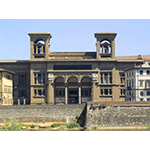Biblioteca Nazionale Centrale di Firenze BNCF [Central National Library of Florence]
The Library originated from the book holding of Antonio Magliabechi, consisting of some 30,000 volumes and bequeathed to the city of Florence in 1714. In 1737, the grand-ducal administration established that the works published in Florence should be deposited there, and in 1743, the rule was extended to all works published in Tuscany. The Library opened to the public in 1747. In 1774, it was assigned part of the library of physician Antonio Cocchi. Considerable increments arrived following the suppression of church foundations. In 1861, it was united with the Palatine Library, formed by Grand Duke Ferdinand III of Lorraine. In 1885, it took the name of National Library and, in 1875, appellative of Central. In 1870, it was given printing rights on national territory. Originally housed in the Palazzo della Dogana, adjoining the Uffizi, the Library was transferred to its present, specially built headquarters in 1935. The 1966 flood caused serious damage: part of the holding was either lost or damaged. Following the event, the Centre for Book Restoration was instituted, and is still active today. The Library publishes the Bibliografia Nazionale Italiana, and is the pilot headquarters for the institution of the National Library Service.
Its manuscripts of scientific interest include the precious Galilean collection and the Targioni Tozzetti holding. The main nucleus of the Galilean collection, born of the obstinate commitment that Vincenzo Viviani put into conserving and recovering it, and later the property of Giovanni Battista Clemente de’ Nelli, was purchased by Ferdinand III in 1818. Further increased with other Galilean manuscripts from libraries, archives and private collections, it was first ordered by the Grand Duke himself. Reordered by Vincenzo Antinori, the Collection consisting of 348 volumes is divided into five sections: the first gathers documents that belonged to Vincenzo Galilei; the second comprises manuscripts by Galileo Galilei; the third section contains several documents by the scientist’s contemporaries; the fourth conserves codices by Benedetto Castelli, Bonaventura Cavalieri, Evangelista Torricelli and Vincenzo Viviani, while the fifth contains the papers that belonged to the Accademia del Cimento. An appendix follows, containing papers and documents of Galilean interest, donated to the library by Antonio Favaro, curator of the national edition of the works of Galileo Galilei.
The Targioni Tozzetti holding comprises manuscripts that at different times became part of the National Library patrimony. The first nucleus was purchased for the Palatine Library by Grand Duke Leopold II in 1851. The second nucleus, consisting of manuscripts by Giovanni, Ottaviano and Antonio Targioni Tozzetti, and the papers of Pier Antonio Micheli, including the Micheli-Targioni herbal, was sold to the National Library in 1894. The miscellanea of the Targioni library and the printed works of the Tozzettis’ were purchased by the Magliabechi Library in 1857. The entire collection comprises texts of botany, mineralogy, biology, geology, chemistry, agriculture and medicine, along with literary pamphlets, travelogues and autographs of illustrious personages.
The Library preserves eighteenth, nineteenth-century collections of dried plants from the manuscript holdings of the religious corporations suppressed between the 18th and 19th centuries. It also presents a pair of globes (celestial and terrestrial), made by Venetian cosmographer Vincenzo Coronelli in 1696 and dedicated to William III of Orange, King of England.
Emblems of science are also found outside of the Library. On one of the turrets of the facade (on the viewer’s right) is the statue of Galileo Galilei holding up his telescope. Also on the facade is a series of medallions dedicated to famous personages. Among them, Leonardo da Vinci and, again, Galileo.
****************************
Texts by Anna Toscano
English translation by Victor Beard
Last update 09/ott/2008




